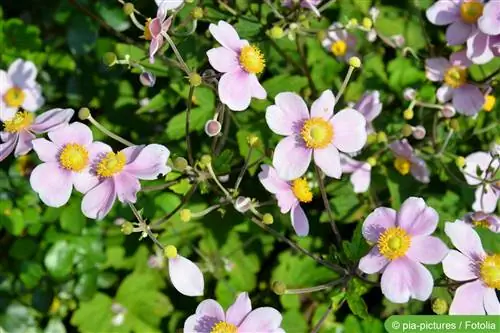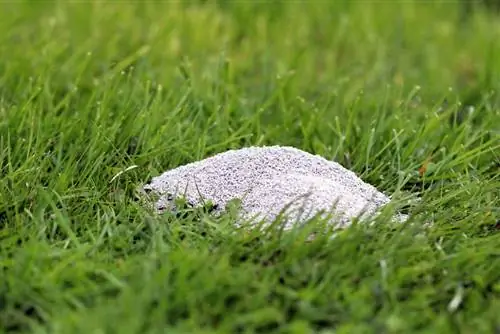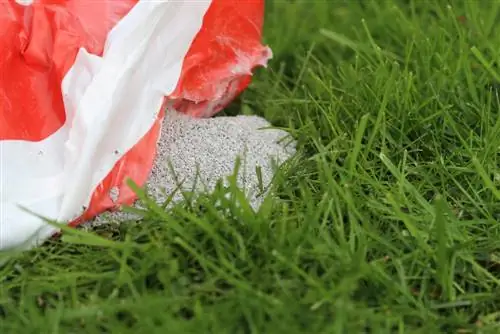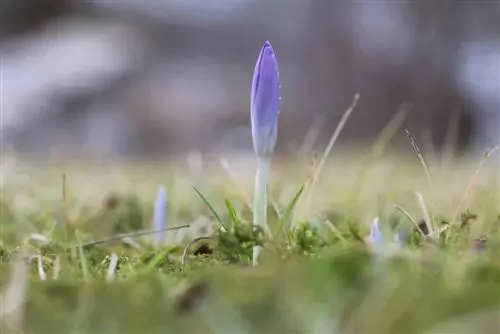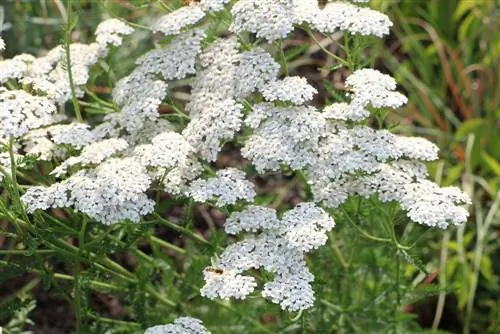- Author admin [email protected].
- Public 2023-12-17 03:39.
- Last modified 2025-06-01 06:48.
When the summer flowers fade and the days get longer, the time of the autumn anemone has come. Their splendor of flowers makes the autumnal garden shine. Lush flowers in many colors enchant from late summer to October. Year after year, the different varieties of 'Anemone hupehensis' bring shine to the garden with their lush flowers. Many varieties remain in one location for 35 years without losing their vigor and flowering ability.
The 'Anemone hupehensis' belongs to the group of autumn anemones. The clarity of their flowers is impressive. This perennial should not be missing in any garden. It only blooms when other plants are already starting to show fruit. Now the autumn anemone is a real eye-catcher in the garden. The color palette of its flowers ranges from simple white, pink, rose, to bright carmine red. Their flowers are simple or double. Depending on the variety, there are up to 15 flowers on a single stem. Despite its delicacy, the 'Anemone hupehensis' is robust, easy to care for and hardy. In the right location, it blooms lushly and powerfully for over 30 years.
Location
All autumn anemones are easy to care for, long-lasting and require little. A slightly loamy, nutrient-rich and humus-rich soil is the ideal place for the 'Anemone hupehensis'. She thanks you with lush clusters of flowers. This delicate perennial loves sunny to partial shade. The autumn anemone feels particularly comfortable in partial shade on walls and trees. If it is in a sunny spot, the soil needs sufficient moisture. If these conditions are met, this delicate perennial will thrive and bloom in the same place for decades.
Care
The autumn anemones are easy to care for and long-lasting. To ensure that it stays that way, it is important to ensure that the soil is sufficiently moist. Pruning at the end of autumn increases the flowering potential next year and a thin layer of compost provides sufficient winter protection. This magical perennial doesn't need anything else.
The 'Anemone Hupehensis' likes partially shaded to sunny places and well-drained soil. There is a rule of thumb. This says that the brighter the location, the more the autumn anemone blooms and grows. However, if the plants are on one side in the shade or in the sun, the flower stems grow towards the light and they lose their stability. The autumn anemones can only tolerate a place in full sun if the soil is sufficiently moist. When waterlogged, the roots rot and the autumn anemone dies.
This perennial forms runners and spreads in loose, humus-rich soil and quickly covers bare spots in the garden. If the spread is welcome, the soil must not be hoeed. The foothills are destroyed. Long rain showers make the many flowers too heavy for the delicate stems. Perennial rings support several flower stems at once and provide good support.
Popular varieties
- Anemone japonica 'Honorine Jobert' - garden autumn anemone, white flowers from summer to autumn.
- Anemone hupehensis 'Rose Bowl' - purple-pink flower, large-flowered, great variety.
- Anemone japonica 'Honorine Jobert' - large-flowered, richly blooming historical variety with elegantly shaped white, semi-double flower bowls
- Anemone hupehensis 'Superba' - lemon yellow flower center surrounded by five bright purple petals that lighten towards the petal tips.
- Anemone tomentosa 'Robustissima' - felty autumn anemone with pale violet-pink colored cup flowers that sit together in panicles from August to October.
Propagate
Spring is the best time for transplanting and propagating autumn anemones. Now is the right time to divide the perennials. Now plant the new seedlings elsewhere and water them. New plants are also grown from root cuttings of the 'Anemone hupehensis'. The best time is late autumn. Cut pieces from the roots of he althy, large mother plants with a sharp knife. They later form roots, sprout stems and leaves and after a while become compact, small plants.
First expose the root ball of the mother plant. To avoid any damage, the mother plant is immediately planted and watered after cutting off a few strong roots. Now cut the thick roots that have been cut off into pieces 5 to 7 cm long. Cut the lower end of the cutting diagonally and the upper end straight. Now stick the slanted end into the potting soil of the propagation boxes or pots. The propagation boxes stay in a bright, cool place in the basement, garage or in an unheated cold frame over the winter. In the spring they have formed roots. Once the cuttings have developed two to three pairs of leaves, the plants are hardened off. In their final location, they will soon be the eye-catcher in the autumnal garden for many years to come.
Tip:
In the first few days the small plants still need protection from full sun.
Diseases
Diseases or parasites play a minor role in autumn anemones. Nematodes (small leaflets) can colonize some varieties. Yellowish, watery spots on the leaves indicate such an infestation. Dispose of the affected plants completely. When planting a new plant, choose a different location.
Wintering
Even in winter, autumn anemones require little care. The perennial is prepared for winter by cutting it back to hand height. A sharp and clean cutting tool is important. It is still possible to cut back shortly before budding in the spring. In very cold regions, winter protection made from brushwood or autumn leaves is recommended after flowering. Even if severe frosts threaten, the root area needs protection from brushwood. In the first two years of growth, the autumn anemones need winter protection. After that only in extreme weather. Plant pots always need winter protection and a frost-free base to protect them from freezing.
Usage
The autumn anemones can be combined with many trees, perennials and grasses. They work particularly well next to hydrangeas, rhododendrons and other shrubs. Plant combinations with ferns, monkshood, silver candle, hostas or sprigs also provide the right setting for these delicate beauties. Although the 'Anemone hupehensis' looks particularly attractive in the garden, it is also a visual highlight in the vase.
pot planting
The 'Anemone hupehensis' is a welcome guest on the balcony and terrace, especially in autumn. Cloudy days have no chance, as the radiantly beautiful flowers drive away any melancholic mood. And if you want to enjoy the beautiful, sunny autumn days on your balcony or terrace, you can enjoy the abundance of flowers of this unique plant with all your senses.
Frequently asked questions
My autumn anemone is infested with nematodes. Can I still save her?
Unfortunately no. The affected plants must be rigorously destroyed. Autumn anemones can no longer thrive in this location.
Can autumn anemones growing in a container stay outside in winter?
Yes, the plant can tolerate it if winter protection protects the pot from freezing. A piece of Styrofoam also belongs under the bucket. It protects the plant from frost from below.
What you should know about the autumn anemone in brief
External features
- Depending on which variety you choose, the autumn anemone has bright green leaves that are sometimes more or less deeply slit.
- In the period from September to October, long flower stalks protrude from the leaves. They have delicate flowers that are star-shaped or cup-shaped.
- The colors also depend on the variety, ranging from white to pink to a beautiful autumnal crimson red.
- In the middle of flowering, the autumn anemone is between 60 and 100 cm high.
Site conditions
- Autumn anemones thrive best in humus to loamy garden soil.
- The location should be warm and sunny, although the autumn anemone can grow in a partially shaded location.
- However, you should not choose a location under trees that cast a strong shadow.
- The autumn anemone cannot tolerate the heavy drops falling from a treetop, which is not uncommon during autumn rainfall.
- The soil should always be well moist, but waterlogging must be avoided at all costs.
- When there is standing moisture and soil compaction, autumn anemones rot very quickly.
Tip:
Especially if you have chosen a rather sunny location, the moisture in the soil should be checked regularly. The rule of thumb applies here: the sunnier the location, the wetter the soil.
Care
- If you worry about the required watering, autumn anemones are quite undemanding in terms of care.
- However, you should prune later in the fall. If the frosty nights slowly increase, you should provide a thin layer of compost.
- In spring you should also cut down the autumn anemones to be on the safe side. They are sometimes a bit sensitive to frost.
- To propagate autumn anemones, the runners are simply separated in spring and can be planted in other locations.
- Autumn anemones can also be placed in a vase to create a happy autumnal atmosphere in your home.
- Attention: If you cut the autumn anemone too early for the vase, the buds will no longer be able to open.
- It is recommended to only plant autumn anemones in large groups of one species. Some varieties do not grow through runners, but grow like clumps.
- Alternatively, the autumn anemone can also be perfectly combined with ornamental grasses, such as pennisetum.
Special style
A special type of autumn anemone is the Chinese autumn anemone lat. Anemone hupehensis. This undemanding ground cover is ideal for partially shaded locations and spreads quickly thanks to its runners. It can also be easily propagated, so that the Chinese autumn anemone can be used in many places in the garden.

